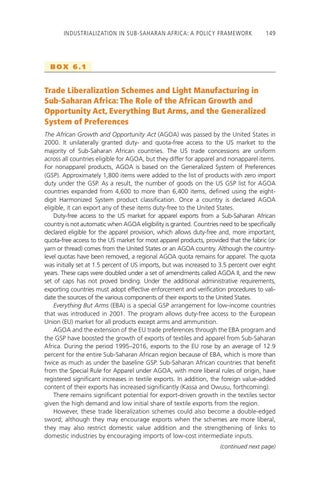INDUSTRIALIZATION IN SUB-SAHARAN AFRICA: A POLICY FRAMEWORK 149
BOX 6.1
Trade Liberalization Schemes and Light Manufacturing in Sub-Saharan Africa: The Role of the African Growth and Opportunity Act, Everything But Arms, and the Generalized System of Preferences The African Growth and Opportunity Act (AGOA) was passed by the United States in 2000. It unilaterally granted duty- and quota-free access to the US market to the majority of Sub-Saharan African countries. The US trade concessions are uniform across all countries eligible for AGOA, but they differ for apparel and nonapparel items. For nonapparel products, AGOA is based on the Generalized System of Preferences (GSP). Approximately 1,800 items were added to the list of products with zero import duty under the GSP. As a result, the number of goods on the US GSP list for AGOA countries expanded from 4,600 to more than 6,400 items, defined using the eightdigit Harmonized System product classification. Once a country is declared AGOA eligible, it can export any of these items duty-free to the United States. Duty-free access to the US market for apparel exports from a Sub-Saharan African country is not automatic when AGOA eligibility is granted. Countries need to be specifically declared eligible for the apparel provision, which allows duty-free and, more important, quota-free access to the US market for most apparel products, provided that the fabric (or yarn or thread) comes from the United States or an AGOA country. Although the countrylevel quotas have been removed, a regional AGOA quota remains for apparel. The quota was initially set at 1.5 percent of US imports, but was increased to 3.5 percent over eight years. These caps were doubled under a set of amendments called AGOA II, and the new set of caps has not proved binding. Under the additional administrative requirements, exporting countries must adopt effective enforcement and verification procedures to validate the sources of the various components of their exports to the United States. Everything But Arms (EBA) is a special GSP arrangement for low-income countries that was introduced in 2001. The program allows duty-free access to the European Union (EU) market for all products except arms and ammunition. AGOA and the extension of the EU trade preferences through the EBA program and the GSP have boosted the growth of exports of textiles and apparel from Sub-Saharan Africa. During the period 1995–2016, exports to the EU rose by an average of 12.9 percent for the entire Sub-Saharan African region because of EBA, which is more than twice as much as under the baseline GSP. Sub-Saharan African countries that benefit from the Special Rule for Apparel under AGOA, with more liberal rules of origin, have registered significant increases in textile exports. In addition, the foreign value-added content of their exports has increased significantly (Kassa and Owusu, forthcoming). There remains significant potential for export-driven growth in the textiles sector given the high demand and low initial share of textile exports from the region. However, these trade liberalization schemes could also become a double-edged sword; although they may encourage exports when the schemes are more liberal, they may also restrict domestic value addition and the strengthening of links to domestic industries by encouraging imports of low-cost intermediate inputs. (continued next page)

